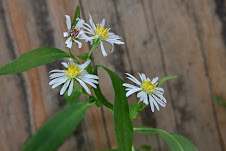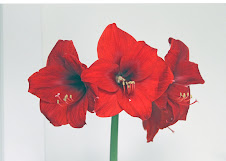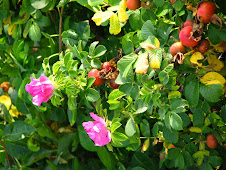The Panicled Aster or Eastern Lined Aster is a member of the large family Asteraceae. The Latin names are “Aster lanceolantus” and “Aster simplex”). Aster is a Greek word for star which describes the radiate heads of the flowers. The Latin word “lanceolatus” means lance-shaped which describes the long thin leaves. The plant is commonly found along wet stream banks in wooded areas and can grow in good and poor soil. I found this still blooming plant two day ago growing on the bank of our driveway under cedar trees. Even though the plant has lovely white daisy-like flowers it is considered a pesky weed.
The Panicled Aster can be distinguished from its other numerous family members because it blooms in autumn from September to November. The flowers are smaller than a quarter, around ¾ inches across. The white flower petals, which number 20-40, are white and curl up as the flower dies. The white or sometimes violet tinged petals surround a yellow center which turns brown from age. This perennial prefers partial sun and grows from one to 3 feet tall. The alternate leaves are smooth or slightly toothed along the leaf edge.
The Aster family contains 20,000 species worldwide. It and the Orchid family are the two largest plant families. Asteraceae has been known as the daisy or sunflower family (Compositae). Several members of the Aster family have been used historically and are presently used as medicine and food. The Eastern Lined Aster was used by the Native American tribe Mohawk for treating fever.
Native Aster plants need little care, bear lovely flowers, and attract butterflies.
Roaming the internet I came across Thomas Elpel’s fascinating description of Asteraceae. The uniqueness of this family is that what appears to be a single flower are many flowers. This is easier observed in a sunflower head than in the small flower of the Eastern Lined Aster. If I had a magnifying glass with me you could view the many flowers in the yellow head of the Eastern Lined Aster.
Many species of Asters have been developed into horticultural ornamentals such as marigold, Zinnias, etc. Other species have been developed into edibles, such as, artichokes, sunflower, etc.
The Aster family can be divided into a Dandelion Subfamily and an Aster Subfamily. Under the Aster Subfamily are nine tribes. Some of them are the Artichoke Tribe, Ragweed tribe, Chamonile Tribe etc.
This is amazing but a little confusing so I will stop for now.
Wednesday, November 16, 2011
Subscribe to:
Comments (Atom)



















LP_gardening_2666.jpg)
LP_gardening_2668.jpg)

LP_garden_2819.jpg)

LP_flower_0563.jpg)
LP_flower_0577.jpg)
LP_flower_0545.jpg)
LP_flower_0555.jpg)
LP_flower_0539.jpg)
LP_dog_0470.jpg)
LP_snow_0467.jpg)
LP_dog_0349.jpg)
LP_tree_8153.jpg)
LP_5028.jpg)
LP_flowers_3940.jpg)

LP-grass_0889.jpg)
LP_redfox_1651.jpg)
LP_squirrel_6978.jpg)
LP_flower_6936.jpg)
LP_squirrel_6864.jpg)
LP-deer_4773.jpg)
LP_4521.jpg)
LP_1251.jpg)
LP_4585.jpg)
LP_3784.jpg)
LP_3759.jpg)
LP_3811.jpg)
LP_3816.jpg)
LP_3847.jpg)
LP_0870.jpg)
LP_4183.jpg)
LP_0891.jpg)
LP_3175.jpg)
LP_3577.jpg)

LP_3068.jpg)
LP_3058.jpg)
LP_3562.jpg)
LP_0118.jpg)
LP_3407.jpg)
LP_3150.jpg)
LP_3011+(2).jpg)
LP_3020.jpg)
LP_2830.jpg)
LP_2782.jpg)
LP_2828.jpg)
LP_1746.jpg)
LP_2648.jpg)
LP_2666.jpg)
LP_2668.jpg)
LP_2493.jpg)
LP_2611crop.jpg)


LP_2588.jpg)






LP_2126.jpg)
LP_2122.jpg)





